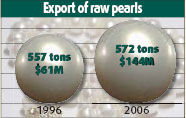Bigger, better: China flexes its mussels
|
From a single mussel, farmers in Zhuji of East China's Zhejiang Province can cultivate scores of pearls of different colors and shapes. Stephen Bloom |
When they pulled in some mussels, the professor, Stephen Bloom from The University of Iowa, couldn't wait to open the shells.
"White, pink, gold, there were some 40 pearls of different colors and shapes in one mussel," said Bloom.
"Chinese freshwater pearls are getting larger, heavier, more colorful and less expensive, which will bring great impact to the world's pearl market."
Shi Hongyue, deputy secretary general of the Gems & Jewelry Trade Association of China, agrees with Bloom.
Chinese pearls now constitute more than 95 percent of the world's total pearl production and almost 100 percent of the world's freshwater pearls.
China's annual pearl yield amounts to 1,500 tons, with one third exported to Hong Kong, India, the US, Taiwan and Japan, said Shi, who has specialized in the industry since 2000.
India, the US, Taiwan and Japan, said Shi, who has specialized in the industry since 2000.
Exports of raw pearls in 2006 reached 572 tons, with a value of $144 million, compared to $61 million in 1996, when 557 tons were exported.
Chinese pearls are becoming more popular with Western consumers, Bloom said. Although there is little difference in appearance between necklaces made in Australia and China, the price difference is staggering. A strand of Australian pearls priced at $15,000, a strand of equal quality Chinese pearls is only $500.
In the past, only the top 1 percent of the world's population could afford to enjoy the "perfect" pearl. But mass production of freshwater pearls in China since 1995 is changing the world market.
"Today, it is pearls for the people," said Bloom.
This is an echo to a statement that Chairman Mao Zedong made half a century ago.
In 1958, Mao visited a salt water pearl cultivation experiment site in Guangdong Province and said: "The people used to labor hard and contribute pearls to the emperors. We are cultivating the pearls for the country and the people."
Cultivation of domestic pearls began in the 1950s in eastern and southern China.
By inserting diverse types of tissue into the shell as pearl-starters, Chinese farmers harvest multi-colored freshwater pearls in one single mussel.
Besides maturing technology, China's upsurge is due partly to the low cost of labor. Pearl sorters, young women aged 15 to 22 who can quickly pick out matching shapes and hues from bags stuffed with pearls, make about 1,200 yuan ($155) a month in Zhuji, versus about $2,500 ($323) in Kobe, Japan.
Modern pearl cultivation started in Japan in the 1880s. But the industry has declined since the 1970s when pollution-caused red tides, earthquakes and high intensity cultivation dealt heavy blows to the salt water akoya oysters that used to dominate the world market.
But to take up the high-end domestic and international market, Chinese producers, designers and dealers still have a long way to go.
While the caliber of artificially-induced pearls has been rising steadily, consumers have a hard time distinguishing good from better from best, and most Chinese have yet to regard pearls with the same level of value as gold, diamonds or jade.
The National Gemstone Testing Center affiliated with the trade association receives some 30,000 diamonds from jewelers and private customers for authentication each month. But fewer than 300 pearls show up, according to Shen Meidong, director of the center's Authentication Department.
Five years ago, the association developed a grading system for cultured pearls that takes into account such characteristics as size, luster, flaws, and roundness with circular pearls. Technicians are gathering "master pearls" and the standards should be finalized and issued in a year's time, said Shen.
Another development in the industry is increased emphasis on finished jewelry for retail sale as opposed to simply exporting raw pearls wholesale. For example, the Zhuji-based Zhejiang Grace Pearl Jewelry Co Ltd has gained approval to market its Grace Pearls as an authorized Olympic product.
Shi said his association is counting on a new promotional activity to help win over younger aficionados the mysterious charms of Miss Pearl, a university student whose identity will be unveiled in May.
"We are confident that her Oriental beauty displays the special attributes of the pearl," Shi said.
(China Daily 03/30/2007 page19)















